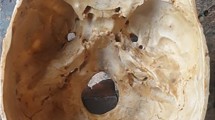Abstract
Microneurosurgical cadaveric dissections have become popular due to their usefulness in obtaining a working knowledge of the microneurosurgical anatomy in a controlled environment. This same controlled environment is also conducive to experiment with new surgical approaches. These factors have increased the number of microneurosurgical anatomic laboratories. Despite the increase in microneurosurgical laboratories, there is very little literature regarding the logistics of starting and maintaining a new neurosurgical laboratory. The aim of this paper is to provide a general road map and basic guidelines in starting and running a microneurosurgical dissection laboratory. The information in this paper is based on a review of the literature and on the experience we gained in organizing and managing the Dardinger Microneurosurgical Skull Base Laboratory at The Ohio State University.




Similar content being viewed by others
References
Aboud E, Al-Mefty O, Yasargil MG (2002) New laboratory model for neurosurgical training that simulates live surgery. J Neurosurg 97:1367–1372
Alvernia JE, Fraser K, Lanzino G (2006) The occipital artery: a microanatomical study. Neurosurgery 58:ONS114–122, discussion ONS114-122
Chan WY, Matteucci P, Southern SJ (2007) Validation of microsurgical models in microsurgery training and competence: a review. Microsurgery 27:494–499
Cogliano VJ, Grosse Y, Baan RA, Straif K, Secretan MB, El Ghissassi F (2005) Meeting report: summary of IARC monographs on formaldehyde, 2-butoxyethanol, and 1-tert-butoxy-2-propanol. Environ Health Perspect 113:1205–1208
Filipce V, Pillai P, Makiese O, Zarzour H, Pigott M, Ammirati M (2009) Quantitative and qualitative analysis of the working area obtained by endoscope and microscope in various approaches to the anterior communicating artery complex using computed tomography-based frameless stereotaxy: a cadaver study. Neurosurgery 65:1147–1152, discussion 1152–1143
Fox CH, Johnson FB, Whiting J, Roller PP (1985) Formaldehyde fixation. J Histochem Cytochem 33:845–853
Frolich KW, Andersen LM, Knutsen A, Flood PR (1984) Phenoxyethanol as a nontoxic substitute for formaldehyde in long-term preservation of human anatomical specimens for dissection and demonstration purposes. Anat Rec 208:271–278
Gragnaniello C, Nader R, Doormaal T, Kamel M, Voormolen EH, Lasio G, Aboud E, Regli L, Tulleken CA, Al-Mefty O (2010) Skull base tumor model. J Neurosurg 113:1006–1111
Hopwood D (1985) Cell and tissue fixation, 1972–1982. Histochem J 17:389–442
Hopwood D (1969) Fixatives and fixation: a review. Histochem J 1:323–360
Kaya AH, Sam B, Celik F, Ture U (2006) A quick-solidifying, coloured silicone mixture for injecting into brains for autopsy: technical report. Neurosurg Rev 29:322–326, discusson 326
Krishnamurthy S, Powers SK (1995) The use of fabric softener in neurosurgical prosections. Neurosurgery 36:420–423, discussion 423–424
Krucker T, Lang A, Meyer EP (2006) New polyurethane-based material for vascular corrosion casting with improved physical and imaging characteristics. Microsc Res Tech 69:138–147
Macdonald GJ, MacGregor DB (1997) Procedures for embalming cadavers for the dissecting laboratory. Proc Soc Exp Biol Med 215:363–365
Meyer EP, Beer GM, Lang A, Manestar M, Krucker T, Meier S, Mihic-Probst D, Groscurth P (2007) Polyurethane elastomer: a new material for the visualization of cadaveric blood vessels. Clin Anat 20:448–454
Nicholson HD, Samalia L, Gould M, Hurst PR, Woodroffe M (2005) A comparison of different embalming fluids on the quality of histological preservation in human cadavers. Eur J Morphol 42:178–184
Richins CA, Roberts EC, Zeilmann JA (1963) Improved fluids for anatomical embalming and storage. Anat Rec 146:241–243
The Office of Environmental Health and Safety (2009) University Institutional Laboratory Biosafety Manual. The Ohio State University. http://www.ehs.ohio-state.edu/index.asp?PAGE=biosafe.ibsm. Accessed 25 May 2010
Sanan A, Abdel Aziz KM, Janjua RM, van Loveren HR, Keller JT (1999) Colored silicone injection for use in neurosurgical dissections: anatomic technical note. Neurosurgery 45:1267–1271, discussion 1271–1264
Sekhar LN, Estonillo R (1986) Transtemporal approach to the skull base: an anatomical study. Neurosurgery 19:799–808
Tolhurst DE, Hart J (1990) Cadaver preservation and dissection. Eur J Plast Surg 13:75–78
Tschernezky W (1984) Restoration of the softness and flexibility of cadavers preserved in formalin. Acta Anat Basel 118:159–163
Tubbs RS, Loukas M, Shoja MM, Wellons JC, Cohen-Gadol AA (2009) Feasibility of ventricular expansion postmortem: a novel laboratory model for neurosurgical training that simulates intraventricular endoscopic surgery. J Neurosurg 111:1165–1167
Wineski LE, English AW (1989) Phenoxyethanol as a nontoxic preservative in the dissection laboratory. Acta Anat Basel 136:155–158
Zhao JC, Chen C, Rosenblatt SS, Meyer JR, Edelman RR, Batjer HH, Ciric IS (2002) Imaging the cerebrovascular tree in the cadaveric head for planning surgical strategy. Neurosurgery 51:1222–1227, discussion 1227–1228
Author information
Authors and Affiliations
Corresponding author
Additional information
Comments
Peter A. Winkler, Munich, Germany
Salma et al. have described in this paper the fundamental requirements of a microneurosurgical skull base laboratory. The authors have to be recommended for their contribution of some tips and tricks for starting a microneurosurgical cadaver lab.
I personally prefer the term “Laboratory for Neurosurgical Microanatomy©” to underline a new quality of an anatomical laboratory focused on neuroanatomy under an operating microscope and endoscope. The exchange of formaldehyde or glutaraldehyde with ethanol, for example, is of crucial importance to eliminate the toxicity of formaldehyde and to arrest further hardening of the brain tissue.
Although the information presented in this paper may be well-known to the neurosurgeons who have long time working experience in anatomical labs, the information offered by this article may be practical to the wider neurosurgical community. As the authors stressed in their introduction, a large number of neurosurgeons do not have such experience and wish to get involved in such an educational and scientific project.
This article undoubtedly adds to our body of knowledge regarding the project of setting up a microneurosurgical skull base lab.
Rights and permissions
About this article
Cite this article
Salma, A., Chow, A. & Ammirati, M. Setting up a microneurosurgical skull base lab: technical and operational considerations. Neurosurg Rev 34, 317–326 (2011). https://doi.org/10.1007/s10143-011-0317-6
Received:
Revised:
Accepted:
Published:
Issue Date:
DOI: https://doi.org/10.1007/s10143-011-0317-6




